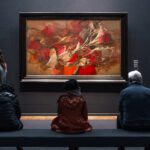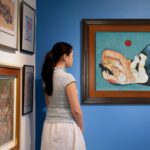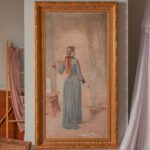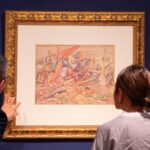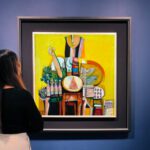It was Henri Matisse himself who once said that creativity takes courage.
The path an artist takes is oftentimes the one less traveled because the truth is, creativity doesn’t come in a thunderous flash of inspiration. Rather, it comes in little nuggets of wisdom that must be cultivated over time.
As an artist, Mauro Malang Santos exemplified the essence of creativity by dedicating his artistic career to its pursuit. He never once stopped learning and refining his art style, even after he received a multitude of accolades for his work.
The works of Malang that we know and love – that feature genre scenes, vendors, and mothers and children – are in many ways a culmination of his life’s work: the result of hours spent honing his craft, exploring the shapes and colors that would eventually be his own. Malang didn’t become Malang overnight, this is why his earlier works are deemed rare and valuable.
It’s also why people take note when works created in different parts of Malang’s career become available on the secondary market. Winning any of these pieces at auction is tantamount to owning a piece of the artist’s past. Gavel&Block’s upcoming Under the Tree online auction features a number of works that span his career.
Read on to see how this modern master’s style fearlessly evolved over the years – and perhaps add a number of them to your holiday wishlist!
Malang, Mother and Child
Have you ever wondered why we refer to Mauro Malang Santos simply as “Malang?” The answer is simple— the artist signed all of his work as “Malang” as a touching homage to his mother.
Naturally, Malang found himself drawn to the motif of the mother and child. So much so that he ended up creating various versions of this subject matter.
It’s an icon that collectors can’t get enough of as it strikes familiar chords and calls to mind fond memories. Malang excels at breathing new life into this enduring motif- adding new details to every iteration: an eye-catching color detail here, the mother’s head tilted lovingly to the side, and a fresh new palette that draws the eye in new and exciting ways each time.
Just this year, during the Important Philippine Art sale of the year’s biggest annual auction event, The Well-Appointed Life, the sale of Malang’s 2003 oil on canvas ‘Mag-ina’ set a world record based on size for the artist, with the 14 x 10 inch painting selling at an astonishing PHP 2,160,800, inclusive of the buyer’s premium.
But did you know that before establishing his signature style as a painter, Malang first had a prosperous career as an illustrator and cartoonist?
The Manila Chronicle
At the age of nineteen, Malang left the University of the Philippines’ School of Fine Arts after only a semester. Soon after, he landed his first job at the Art Department of The Manila Chronicle. This marked the beginning of his career as an artist and cartoonist.
Essentially a self-taught artist, the only other art instruction that Malang received aside from his semester at the University of the Philippines, was the informal art lessons he took from his neighbor as a young boy. Malang never allowed the notion that he was a self-taught artist to hold him back from pursuing a career in this highly competitive field.
At the Manila Chronicle, he first worked as an apprentice of cartoonist, Liborio “Gat” Gatbonton, who would eventually become his lifelong friend. Under Gat’s guidance, Malang was able to channel his creativity into one of his most iconic works: Kosme the Cop.
During this time period, many comic strips made use of the police as its main characters. Like Kosme the Cop, they poked fun at common stereotypes associated with the police force in the country.
Kosme the Cop set itself apart by becoming the country’s first daily comic strip published in the English language.
As Kosme’s popularity grew, Malang decided to revise the comic into Kosme the Cop (Retired), in order to expand the character’s storyline. This way, the narrative of Kosme was no longer limited to his profession as a cop. With this new layer of retirement, Kosme was now able to play different roles such as that of a firefighter, salesman, and even a politician.
Apart from working on Kosme, Malang constantly created editorial cartoons and illustrations for The Manila Chronicle and other well-known publications.
The 1950s
The beginning of the 50s served as a pivotal point in Malang’s career. At this point, he had already made a name for himself as an illustrator and cartoonist but had yet to find his signature style beyond the realm of commercial art.
This era marked an age of increased self-discovery for the artist in terms of his work. Malang intentionally sought to refine his craft by experimenting with different painting techniques across a variety of mediums.
This particular work created in the 1950s is rare and may not immediately be identified as a “Malang.” But, the exaggerated shapes that would find their way into his original cubist technique is already evident. This is what makes the possibility of owning this street scene so intriguing.
Notably, even two decades later, Malang continued to create studies in order to better his work. Even though ‘Black Lady,’ a 1976 charcoal sketch, is not done in his typical exuberant color palette, you can clearly draw similarities between this sketch and many of his later paintings in terms of subject matter.
Malang, much like National Artist Carlos “Botong” Francisco, added his own modern take to what was perceived to be commonly traditional subject matter. In doing so, Malang breathed new life to the understanding and overall look of Philippine Art.
Joyfully browse through over 500 lots, including the Malang pieces in this article, by clicking here to gain access to our online catalogue and virtual gallery for Gavel&Block’s online auction, Under the Tree. The sale will be held live online Saturday 21 November at 11 am.
Image of the artist courtesy of Mr. Soler Santos











